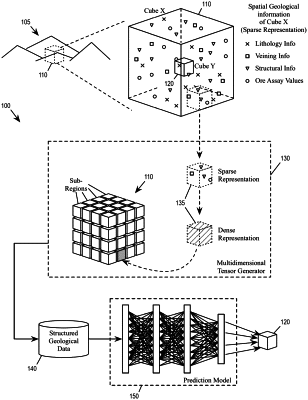| CPC G06N 3/04 (2013.01) [G01V 20/00 (2024.01); G06N 3/08 (2013.01)] | 20 Claims |

|
1. A computing device comprising:
a network interface;
a processor; and
a storage device storing a set of instructions, wherein an execution of the set of instructions by the processor configures the computing device to perform acts comprising:
receiving structured geological data that is derived based on spatial geological information that is converted into tensors and associated with an input region, the spatial geological information comprising one or more different types of data;
training a prediction model to produce a prediction output based on an average grade of an ore of a target mineral type at a target region nested in the input region, by using the tensors of the received structured geological data of the input region, wherein the use of tensors improves the time efficiency of the training of the prediction model;
identifying a relationship of the structured geological data to the prediction output; and
determining a revised input region based on the identified relationship without changing the target region.
|